
Beethoven’s Seventh 2022/2023 SEASON February 16 – 18, 2023
Completely engaged. That’s how Joe Coyle feels about his life at Judson Manor.

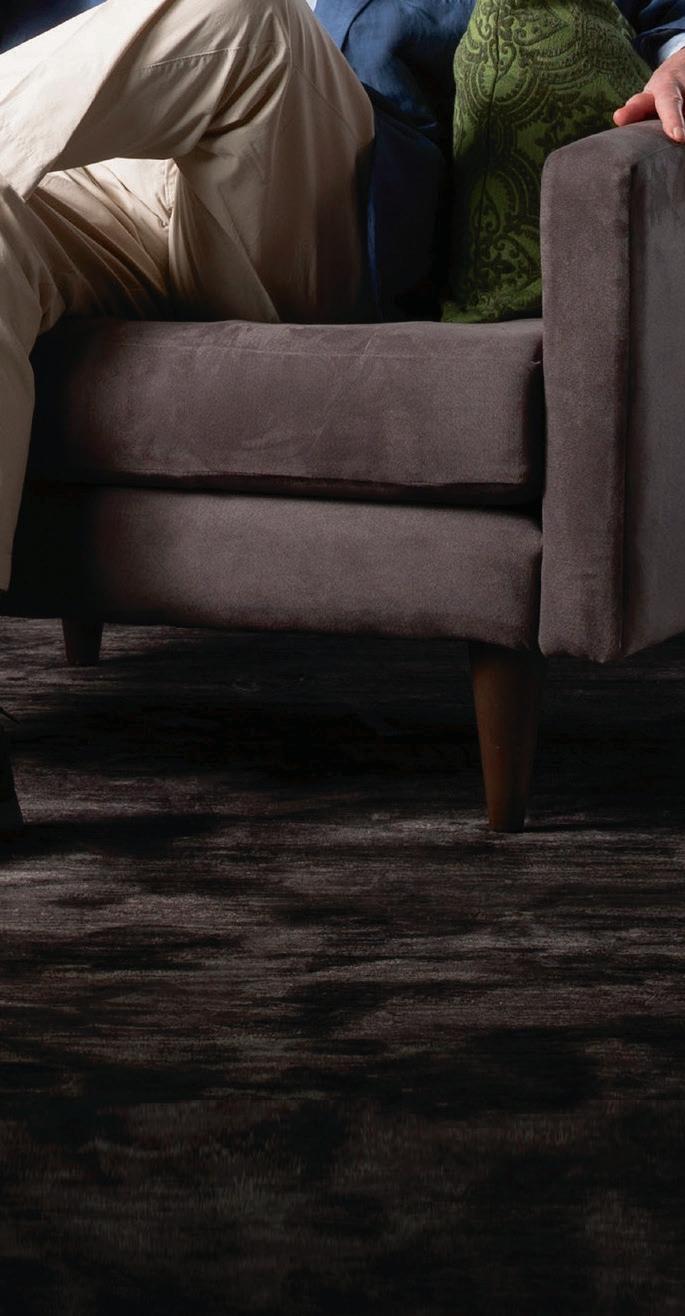

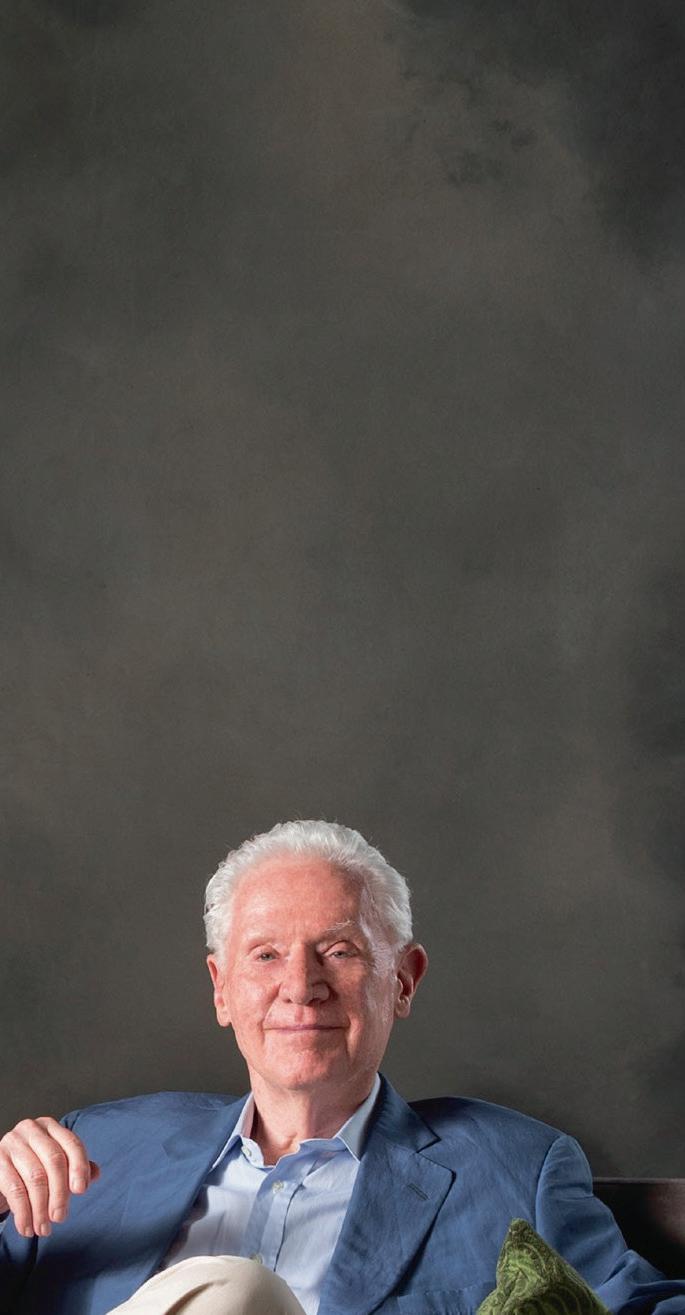
An award-winning journalist who has lived in Paris, Santa Fe, and New York City, he arrived in July 2020 via the suggestion of a fellow resident. He’s been delighted ever since.
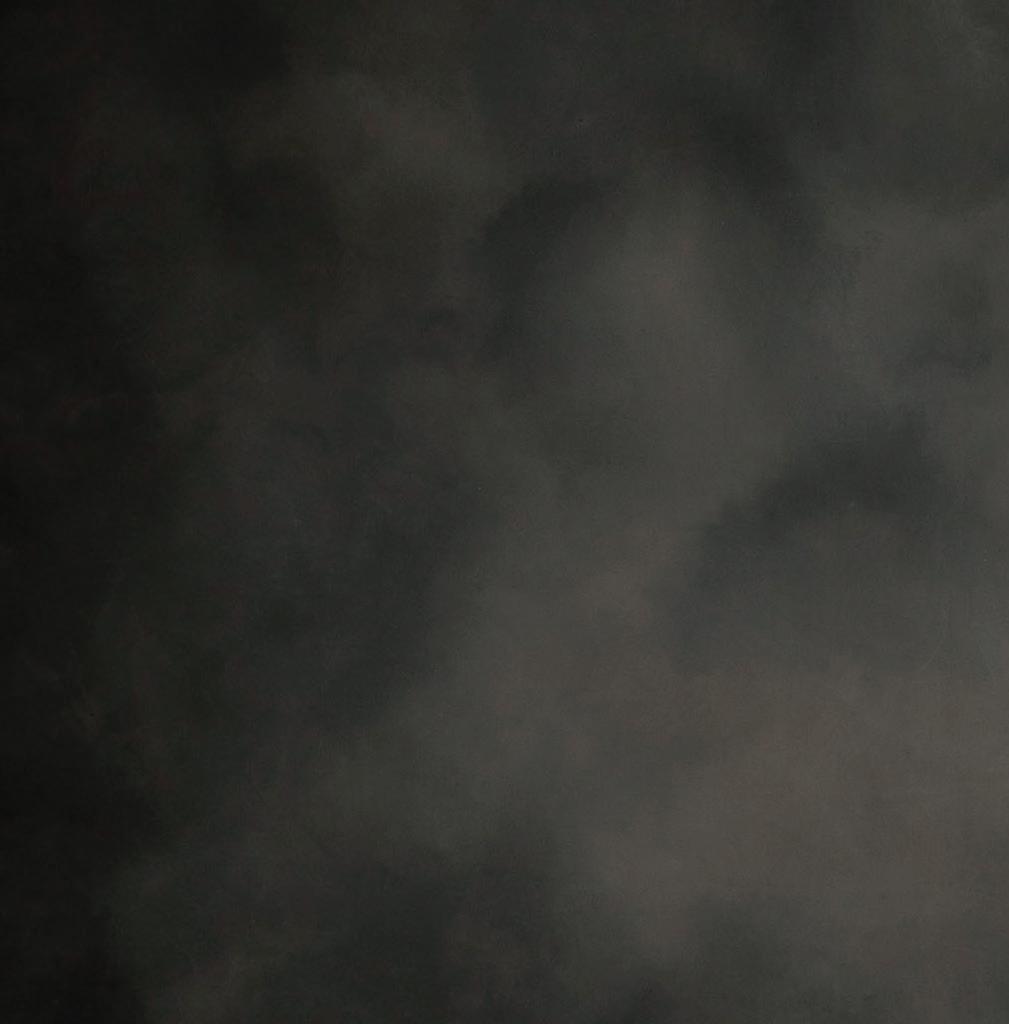
“As a writer, I enjoy spending time alone, and these surroundings are perfect: my apartment is quiet, and the views overlooking the Cleveland Museum of Art are lovely. But by far the best part of Judson is the people. Everyone is so knowledgeable about art and culture. I wanted to have stimulating company to spend my time with, and I’ve found that here. These are wonderful, interesting people,” says Joe.
Read the full story at judsonsmartliving.org/blog
Judson Park Cleveland Heights | Judson Manor University Circle | South Franklin Circle Chagrin Falls Learn more about how Judson can bring your retirement years to life! judsonsmartliving.org | 216.446.1579
“Expanding my curiosity about life is what it’s all about.”
Joe Coyle
2022/2023 SEASON
Beethoven’s Seventh
Thursday, February 16, 2023, at 7:30 p.m.
Friday, February 17, 2023, at 7:30 p.m.
Saturday, February 18, 2023, at 8:00 p.m.
Herbert Blomstedt, conductor
Wolfgang Amadeus Mozart (1756 –1791)
Piano Concerto No. 18 (“Paradis”) 30 minutes in B-flat major, K. 456
I. Allegro vivace
II. Andante un poco sostenuto
III. Allegro vivace
Emanuel Ax, piano
INTERMISSION 20 minutes
Ludwig van Beethoven (1770 –1827)
Symphony No. 7 in A major, Opus 92 35 minutes
I. Poco sostenuto —Vivace
II. Allegretto
III. Presto
IV. Allegro con brio
Approximate running time: 1 hour 25 minutes
Thank you for silencing your electronic devices.
Thursday evening’s concert is dedicated to Mr. and Mrs. Alfred M. Rankin, Jr. and an anonymous donor in recognition of their extraordinary generosity in support of The Cleveland Orchestra.
2022/2023 Season Sponsor
clevelandorchestra.com
COVER:
THE CLEVELAND ORCHESTRA
JACK, JOSEPH AND MORTON MANDEL CONCERT HALL AT SEVERANCE MUSIC CENTER
PHOTO BY ROGER MASTROIANNI
Experience the Orchestra in a whole new way

Your donation to The Cleveland Orchestra keeps the music playing. . . AND earns you access to exclusive, behind-the-scenes benefits all season long!
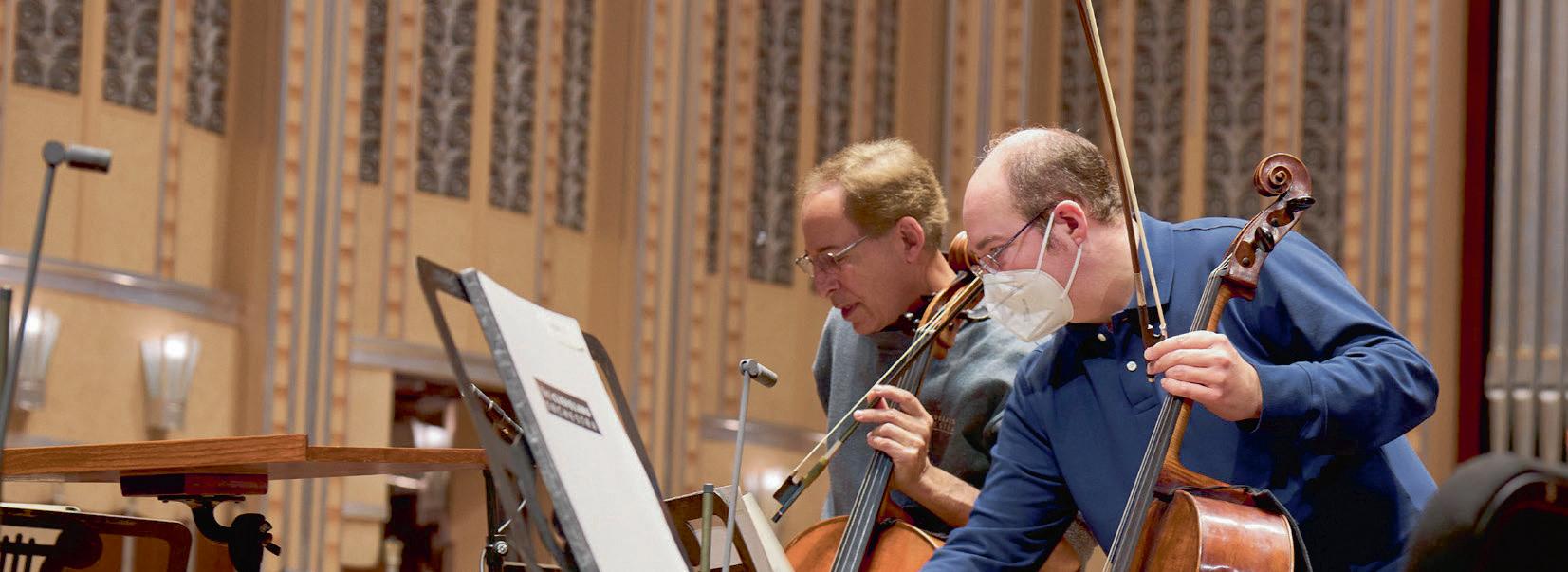
Invitations to Open Rehearsals
Meet the Artist Performances
Early Access + Ticket Discounts
Intermission in the Ginn Suite . . . and so much more!
Make your gift today, and join the fun!
clevelandorchestra.com/give
Orchestra cellists Richard Weiss (L) and Mark Kosower at rehearsal. Photo by Roger Mastroianni.
IT’S HARD TO THINK of anyone who knows Beethoven’s Seventh Symphony better than tonight’s conductor, Herbert Blomstedt (above). After seeing Blomstedt conduct this work with the Boston Symphony Orchestra in August 2021, at the age of 94, New Yorker critic Alex Ross glowingly reported of “a performance that surged with vitality,” “an equilibrium between headlong force and melancholy lyricism,” and “a glorious payoff in the last pages of the finale, when the orchestra let loose with a frothing energy that bordered on animal joy.”
A few weeks earlier, Blomstedt brought that same “frothing energy” to Blossom Music Center, where he joined The Cleveland Orchestra in the same symphony. The performance produced equally stirring results for both musicians and the audience, which gave the reigning eminence of the podium a well-deserved ovation.

While a similarly illuminating rendering of Beethoven’s Seventh is
undoubtedly in store for this weekend’s performance, it will almost certainly reveal fresh insights and novel ideas. Over his career, Blomstedt has shifted his perspectives on the composer, from his metronome markings and tempos to his interpretations of larger themes, often humming a passage to make a point. These adjustments come across in Blomstedt’s two recordings of the complete cycle of Beethoven symphonies (first with the Dresden Staatskapelle from 1975 to 1980 and later with the Leipzig Gewandhaus Orchestra from 2014 to 2017).
“Every time we perform a classical work that we’ve played many times, it is new,” Blomstedt said. “It can never be the same. It’s like making bread, it will always be a little bit different.”
His fellow baker this weekend is his longtime collaborator and friend of the Orchestra, Emanuel Ax, who will help cook up an invigorating account of Mozart’s Piano Concerto No. 18 on the first half of the program. Through the able hands of these two luminaries — one with a baton and the other at the keyboard — Mozart’s two-century-old concerto finds renewed vigor and resonance.
— Amanda Angel
THE CLEVELAND ORCHESTRA | 3 clevelandorchestra.com PHOTO
INTRODUCTION
COURTESY OF HERBERT BLOMSTEDT/SUNTORY HALL
Piano Concerto No. 18 (“Paradis”) in B-flat major, K. 456
By Wolfgang Amadeus Mozart
BORN : January 27, 1756 in Salzburg, Austria
DIED : December 5, 1791 in Vienna
Ω COMPOSED : 1784
Ω WORLD PREMIERE : Mozart recorded Piano Concerto No. 18 in his own catalog of works on September 30. The date of its first performance is unknown; the composer introduced it to Vienna on February 12, 1785.
Ω CLEVELAND ORCHESTRA PREMIERE : October 13, 1949, with George Szell conducting and Leonard Shure as soloist
Ω ORCHESTRATION : flute, 2 oboes, 2 bassoons, 2 horns, strings, and solo piano
Ω DURATION : 30 minutes
BY SEPTEMBER 1784 , Mozart had already composed four piano concertos that year, and two more were to follow.
On September 21, Mozart’s wife, Constanze, gave birth to their second child, Karl, and nine days later her husband completed his fifth piano concerto of the calendar year, this one in B-flat major. Mozart entered the new concerto in his own catalogue of completed works. It was eventually designated as No. 18 in the numbering of his music done long after the composer’s death.
The composer’s father Leopold almost certainly referred to this concerto in B-flat in a letter dated February 17, 1785, written to his daughter from Vienna, where he was visiting: “On Sunday
evening… Madame Laschi gave a concert in the theater, at which… your brother played a glorious concerto which he had composed for Mlle Paradis for Paris. I was sitting only two boxes away and had the great pleasure of hearing so clearly all the interplay of the instruments that for sheer delight tears came into my eyes. When your brother left the platform the Emperor waved his hat and called out ‘Bravo, Mozart!’ And when he came on to play there was a great deal of applause.”
If only Leopold had obliged us by identifying the concerto by key, for it remains only an educated guess that the concerto he heard that evening was what
4 | 2022/2023 SEASON
THE MUSIC
Portrait of Wolfgang Amadeus Mozart, painted posthumously by Barbara Kraft (1819).
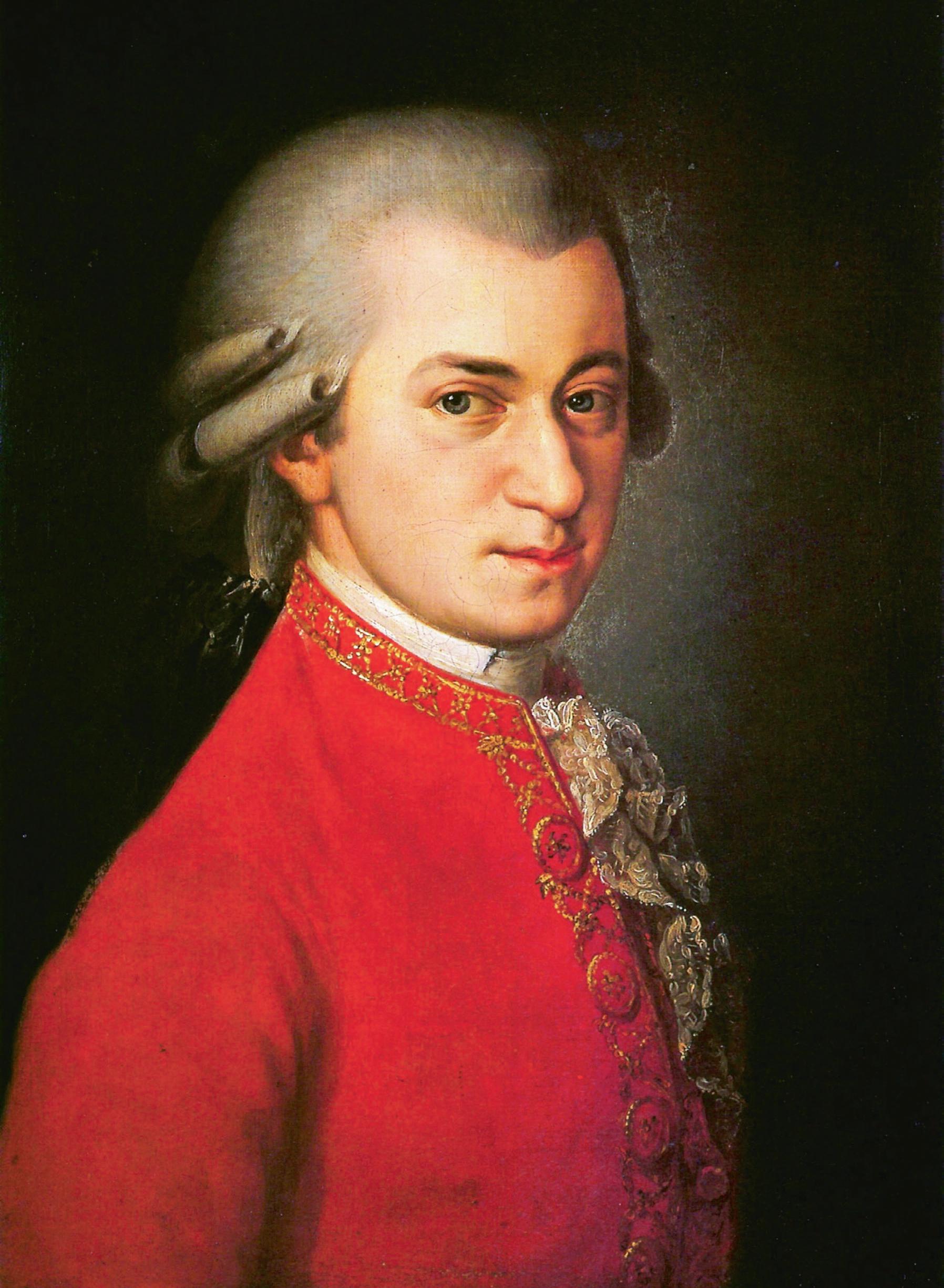
THE CLEVELAND ORCHESTRA | 5 clevelandorchestra.com IMAGE COURTESY OF WIKIMEDIA COMMONS
we know as No. 18 and not one of the other five he composed in 1784. One clue from the manuscript of the concerto is that it includes cadenzas for the first and last movements. This points to the likelihood that the concerto was written for someone else — when Mozart played his concertos himself, he improvised cadenzas. Two previous concertos whose score include fully composed cadenzas (Nos. 14 and 17) were written for Barbara Ployer, a piano and composition student of Mozart’s. So, it seems logical that No. 18, with its fully composed cadenzas, was indeed written for “Mlle Paradis.”
Mademoiselle Maria Theresia von Paradis was celebrated in her time as a composer and virtuoso. That she was blind only added to her renown, as well as her connection to Empress Maria Theresa, to whom the family was close. But of her relations with Mozart we know very little.
Mlle Paradis’s concert in Paris, to which Leopold obliquely refers in his letter, took place earlier in 1784, before the concerto was completed. It is possible that she played it instead in London, where she appeared after Paris that autumn. It is equally possible that she never played it at all.
Irrespective of its official premiere, this concerto illustrates Mozart’s delight in wind instruments. The second subject of the first movement, for example, has a little chirpy tune on two oboes in thirds, to which a flute and a bassoon respond two octaves apart in a smooth line, as if to say “you have your kind of playing,
we have ours.” Although the soloist later plays this theme, its true point has been made by the wind instruments.
The second movement is a remarkable set of variations, not on a simple tune but on a strained, melancholy melody in the minor key with expressive sighs and chromatic harmony. The tune sounds rather like a variation itself, especially in its second half. Furthermore, the variations each contain internal variations, so a generous counting could find 10 variations, not just five.
The first variation is given almost entirely to the piano, and the repeats are observed. The second has a statement by the orchestra, decorated by the piano. The third has a ferocious opening and a gentle response from the piano. The fourth turns to the major key, and the fifth involves both orchestra and soloist throughout. With its heartfelt close, this movement is one of the most elaborate and expressive in all the Mozart concertos.
The third-movement finale, in contrast, is a relatively simple rondo, with a sharp surprise in the middle when Mozart switches suddenly to B minor — a jarring key to classical ears — and introduces 2/4 rhythms in the woodwinds in conflict with the prevailing 6/8 in the strings. This delicious effect looks far more complicated than it sounds, but resolves in a cheery conclusion, as Mozart well intended.
— Hugh Macdonald
6 | 2022/2023 SEASON THE MUSIC
Hugh Macdonald is Avis H. Blewett Professor Emeritus of Music at Washington University in St. Louis. He has written books on Beethoven, Berlioz, Bizet, and Scriabin.
The Blind Pianist Who Inspired Mozart
Maria Theresia von Paradis was born in Vienna in May 1759. Her father was an imperial secretary in the court of Empress Maria Theresa, for whom she was named.
By the time she was 5 years old, Paradis was completely blind. Yet, she exhibited extraordinary musical talent, which was nurtured by the Empress with lessons from the city’s best teachers. Paradis learned to play piano, organ, and sang. She studied with Antonio Salieri, one of the most prominent composers in Vienna at the time who wrote her an organ concerto. Franz Joseph Haydn also wrote her a piano concerto.

In 1783, Paradis embarked on an ambitious tour of Europe. Accompanied by her mother and librettist Johann Riedinger, she created a sensation in Berlin, Paris, London, Switzerland, and Prague. She met Queen Marie Antoinette of France, as well as King George III of England and the Prince of Wales. It was during this tour that she is thought to have premiered Mozart’s Piano Concerto No. 18, now nicknamed in her honor. That same year, she helped establish the first school for the blind in Paris, inspiring Valentin Haüy to found the National Institution for Young Blind People.
During her European tour, Paradis also began composing more music. Riedinger devised a pegboard with differently shaped pegs that allowed her to inscribe notes. Though much of her output has been lost, she wrote several piano sonatas, cantatas, operas, and many songs using this method.
Eventually, Paradis turned her attention away from performing and composition and to teaching. In 1808, Paradis established a music school in Vienna for girls, where she taught singing, piano, and music theory until her death, in 1824.
THE CLEVELAND ORCHESTRA | 7 clevelandorchestra.com
A bust of the blind pianist, singer, and composer, Maria Theresia von Paradis. Her musical talents inspired composers including Salieri, Haydn, and Mozart. PHOTO BY GEORG HAMANN PRIVATARCHIV
Symphony No. 7 in A major, Opus 92
By Ludwig van Beethoven
BORN : December 17, 1770 in Bonn, Germany
DIED : March 26, 1827 in Vienna
Ω COMPOSED : 1811–12
Ω WORLD PREMIERE : December 8, 1813, at a special concert at the University of Vienna with Beethoven conducting
Ω CLEVELAND ORCHESTRA PREMIERE : The second movement was played by itself in November 1919, at the “First Popular Concert” of the Orchestra’s second season. The first performance of the entire symphony at a Cleveland Orchestra subscription concert was by the La Scala Orchestra of Milan, conducted by Arturo Toscanini, on February 2, 1921. The Cleveland Orchestra played the complete symphony for the first time in April 1922, with music director Nikolai Sokoloff conducting. It has been played frequently ever since, most recently at Blossom Music Center on August 1, 2021, with tonight’s conductor, Herbert Blomstedt, at the podium.
Ω ORCHESTRATION : 2 flutes, 2 oboes, 2 clarinets, 2 bassoons, 2 horns, 2 trumpets, timpani, and strings
Ω DURATION : about 35 minutes
IT SEEMS FITTING that the Seventh Symphony, Beethoven’s greatest demonstration of the compelling power of rhythm, received its first hearing through the efforts of Johann Nepomuk Mälzel, inventor of the metronome.
Mälzel was described by one Beethoven biographer as “part Edison and part Barnum,” and while he is best remembered today for the little ticking box that has held generations of music students to the rhythmic straight and narrow,
he mesmerized the public with his more extravagant contraptions, such as the mechanical chess player and the mechanical trumpet, during his lifetime. Beethoven delighted in all sorts of modern devices and was pleased to compose his bombastic Wellington’s Victory for another Mälzel instrument, the orchestra-imitating Panharmonicon.
8 | 2022/2023 SEASON THE MUSIC
This portrait of Ludwig van Beethoven from 1820, by artist Joseph Karl Stieler, is the only painting that the composer sat for during his life.
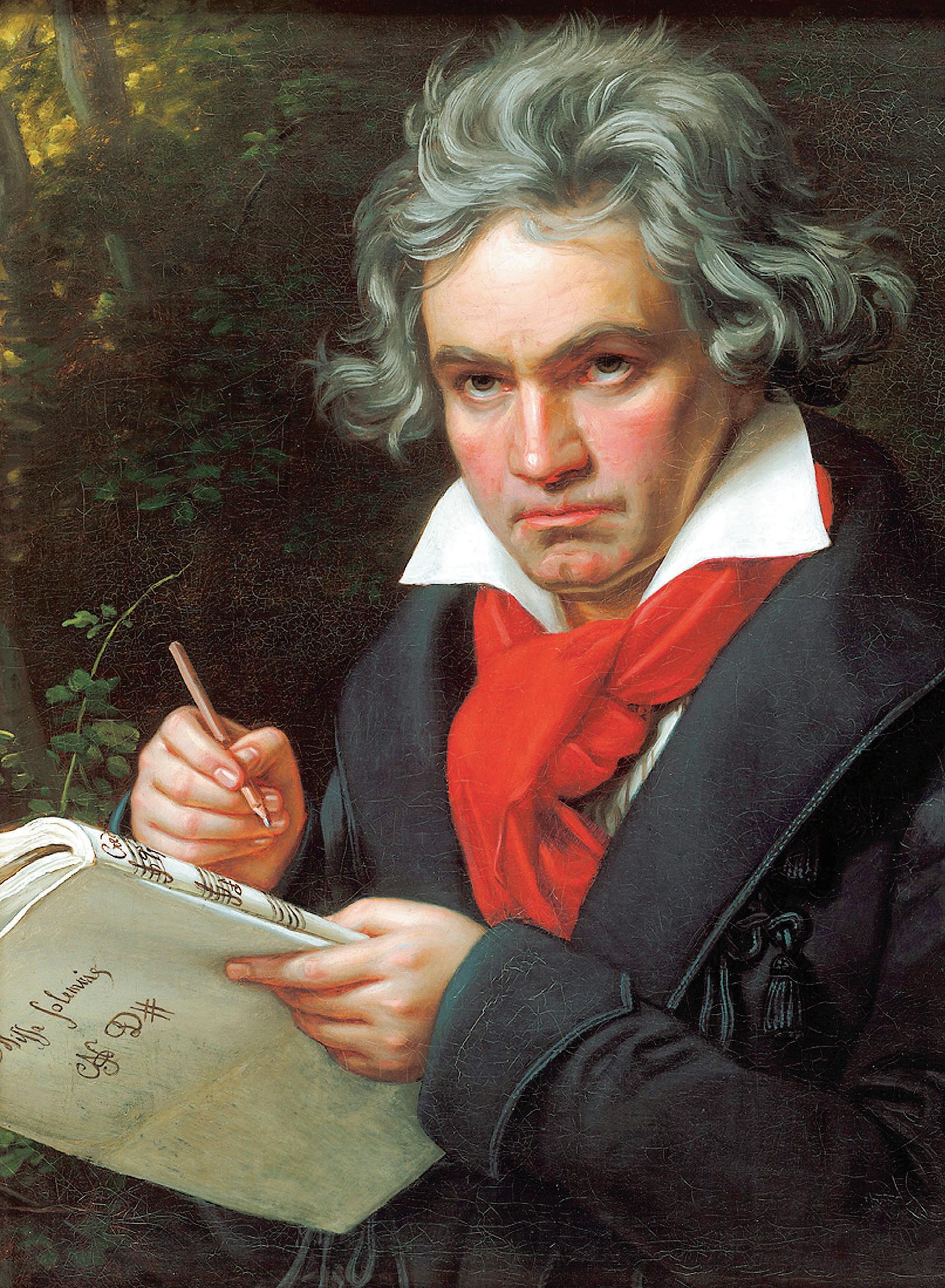
THE CLEVELAND ORCHESTRA | 9 clevelandorchestra.com IMAGE COURTESY OF WIKIMEDIA COMMONS
To help promote this confluence of two very different kinds of genius — his own mechanical and Beethoven’s compositional — Mälzel proposed a triumphal tour of England. This was to be funded by a series of concerts in Vienna. The tour never came off, owing to a dispute between the two men regarding the performing and publishing rights to the music, but the concerts did.
The first concert was organized to benefit Austrian soldiers wounded in the Napoleonic Wars; if that concert succeeded, there would be no problem selling tickets to repeat performances, which would benefit Mälzel and Beethoven. On the program was the latter’s new orchestral arrangement of Wellington’s Victory, attracting patriotic Austrians to the concert; Mälzel’s mechanical trumpet performing marches by Dussek and Pleyel; and, for connoisseurs, the unveiling of an “entirely new symphony” Beethoven had recently finished, his Seventh.

To ensure the event’s drawing power, Mälzel lined up an all-star orchestra, with the great Ignaz Schuppanzigh and Louis Spohr leading the violins, the composer Giacomo Meyerbeer and pianists
Johann Nepomuk Hummel and Ignaz Moscheles playing drums and cymbals, and the venerable Antonio Salieri (teacher of Beethoven and Schubert, and rival of Mozart) cueing the fanfares and salvos.
(While the presence of the 15-year-old Schubert at this concert has not been documented, it has been surmised in view of the influence of the Seventh Symphony in Schubert’s later compositions.)
In rehearsal, Beethoven’s infamous temper was not in evidence. When the violinists complained about the difficulty of their part, the composer politely asked them to take it home and practice. At the next rehearsal, there were smiles and compliments all around.
Beethoven’s unique conducting style, however, was in full flower at the concert on December 8, 1813, with his gesturing perhaps exaggerated because of his deafness. Spohr recalled: “Beethoven was in the habit of giving dynamic indications to the orchestra by means of all sorts of peculiar movements of his body. When he wanted a sforzando [suddenly strong] he would vehemently throw out both his arms, which previous-
10 | 2022/2023 SEASON THE MUSIC
IMAGE COURTESY OF
The best-known invention by Beethoven’s associate Johann Nepomuk Mälzel is the metronome. Coincidently, Beethoven’s metronome markings would become a subject of great interest nearly 200 years later.
WIKIMEDIA COMMONS
ly he had held crossed across his breast. For a piano he would crouch down, going down deeper as he wanted the sound to be softer. Then, at the beginning of a crescendo he would rise gradually, and when the forte was reached he would leap up into the air. Occasionally he would shout with the music in order to make the forte stronger, without being conscious of it…”
At one point, Beethoven’s inability to hear quiet passages led to near disaster when he overlooked the second of two pauses in the recapitulation of the symphony’s first movement. While the orchestra paused, Beethoven continued to beat time, getting himself about 10 bars ahead of the players. Spohr’s description continued: “Beethoven, indicating the pianissimo passage in his own way, had crouched down under the music stand; at the crescendo, which followed, he became visible once more, made himself taller, and then leapt high up in the air at the moment when, according to his calculation, the forte should have begun. When this did not happen, he looked about him in terror, stared in astonishment at the orchestra, which was still playing the pianissimo, and found his place only when the so-long-awaited forte began and became audible to him.”
And how did this cliff-hanging performance of a new, serious work fare amid the hokum and foofooraw of Mälzel’s patriotic spectacle? Very well, thank you. The audience came prepared to be thrilled, and Beethoven’s robust new
The Seventh Symphony’s most striking characteristic may be the synthesis it achieves between the intensity and compression of the Fifth and the rustic high spirits of the “Pastoral” Sixth. Beethoven’s symphonic imagination had lain fallow for three years after he finished those two works, and this new start found him writing with a harmonic daring that enlivens his most obsessive rhythms.
symphony didn’t disappoint. The applause, wrote one journalist, “rose to the point of ecstasy.” Significantly, it was not the symphony’s taut, propulsive outer movements that warranted encores, but the melodious Allegretto, whose major-minor ambiguity so richly anticipated the bittersweet moods of postwar, Biedermeier-era Vienna and its greatest composer, Schubert.
To us latter-day listeners, however, the Seventh Symphony’s most striking characteristic may be the synthesis it achieves between the intensity and compression of the Fifth and the rustic high spirits of the “Pastoral” Sixth. Beethoven’s symphonic imagination had lain fallow for three years after he finished those two works, and this new start found him writing with a harmonic daring that enlivens his most obsessive rhythms. Although the symphony is in A major, the remote keys of C and F
THE CLEVELAND ORCHESTRA | 11 clevelandorchestra.com
figure so prominently that they become tonal centers in their own right, giving this busy music a much-needed sense of space; the third-movement scherzo, in fact, turns the tables by being in F major, but ending its first phrase firmly on an A-major chord.
It was not Beethoven’s harmonic skill, however, but his persistent rhythms that prompted Richard Wagner to call this symphony “the Apotheosis of the Dance.” The work’s patterns are all versions of the dactylic foot — one strong beat, followed by two weaker ones. The simplest form of this is the scherzo’s steady quarter notes in 3/4 meter. Then there is the famous “Schubert-rhythm” of the second-movement Allegretto, which, sped up, becomes the engine that drives the finale. Even the cantering 6/8 of the first movement’s Vivace section is made up of innumerable tiny dactylic cells.
Beethoven has not neglected the thematic unification of this work, either. In particular, themes from the long Poco sostenuto introduction to the opening section cycle throughout the first and later movements. For example, the introduction’s long, rising scales (like “gigantic stairs,” commented the English writer George Grove) can be heard galloping up and down in the development of the movement’s main Vivace section. And this theme’s graceful turns and leaps eventually grow into the whirlingdervish theme of the finale. Later in the first movement, an immensely long crescendo builds over a bass that moans
in semitones; something very similar happens before the coda of the finale (these are said to be the passages that caused Carl Maria von Weber to say that Beethoven was “ripe for the madhouse”) — and both of these moments have a close cousin in the trio theme of the scherzo, with its wavering half-step. Such observations, however, can carry us only a little way toward understanding how a composer can be so bold and so right at the same time. Even associations beyond or outside the music don’t add much. British music writer Donald Francis Tovey wrote that “the symphony is so overwhelmingly convincing and so untranslatable, that it has for many years been treated quite reasonably as a piece of music, instead of as an excuse for discussing the French Revolution.” The revolution, of course, is in the music. And familiar as this music is, it always catches us off guard, from the opening notes — a pregnant oboe theme that Beethoven promptly discards — to the sudden, final A-major cannon shots, which explode any thought of a lengthy “Beethoven coda.”
Asked why he didn’t compose more music in the vein of his best-selling works, Beethoven replied, “Art always demands something new from us.” Two centuries after he wrote it, the Seventh Symphony sounds as new as tomorrow’s premiere.
Wright
12 | 2022/2023 SEASON
— David
THE
David Wright lives and writes in New Jersey. He previously served as program annotator for the New York Philharmonic.
MUSIC
Herbert Blomstedt recorded two full cycles of Beethoven symphonies: first with the Dresden Staatskapelle (1975–80) and then the Leipzig Gewandhaus Orchestra (2014–17). In between, an illuminating new edition of the symphonies, including the composer’s original, faster metronome markings, was released. Blomstedt discusses this development in context of both ensembles’ histories.
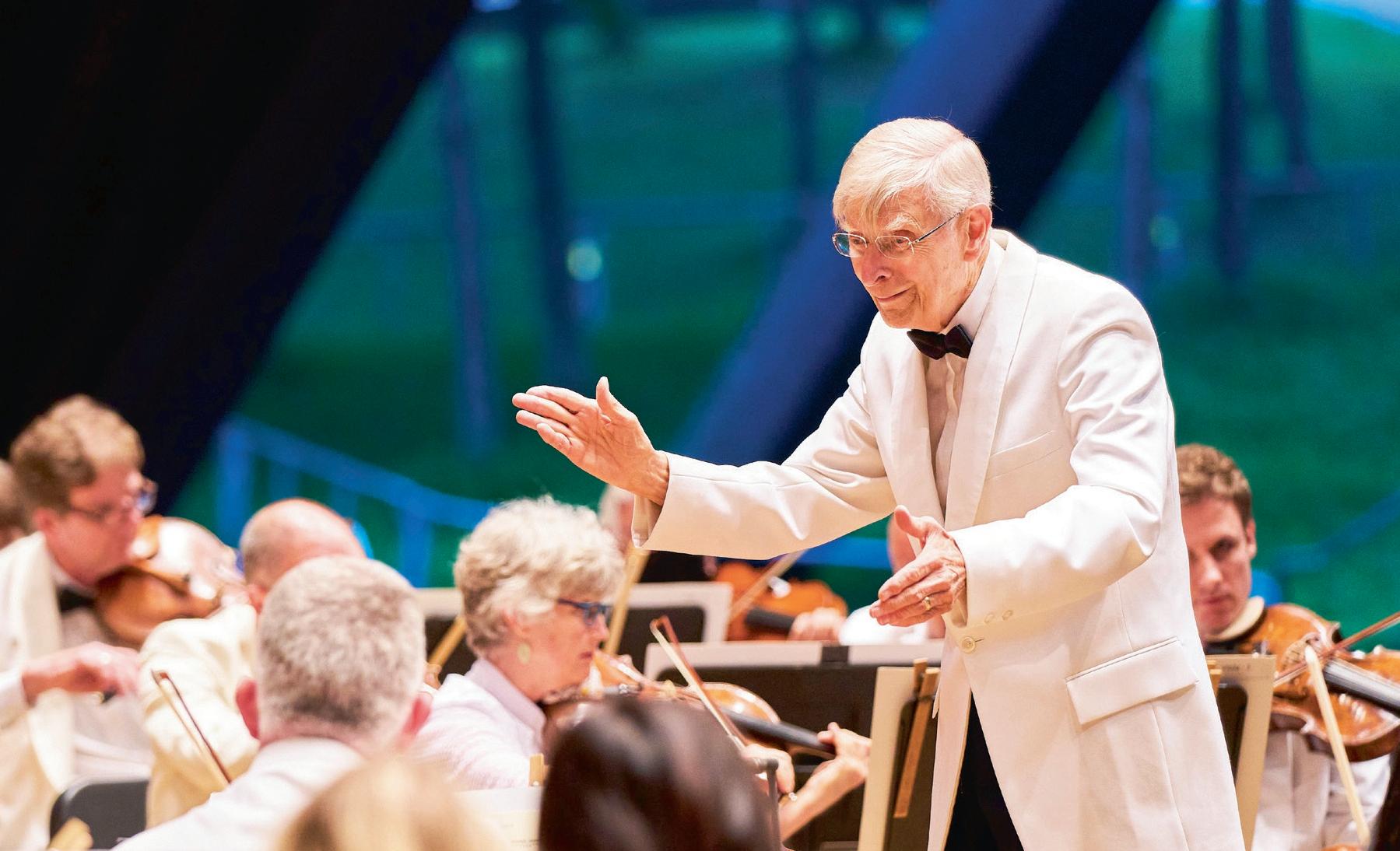
Over the last 20 years, there has been a heated argument. In the old editions [of Beethoven’s symphonies], there were no metronome markings, and those editions have been on the stands of all symphony orchestras for over a hundred years. And now in the new editions that came out about the year 2000, there are markings that stem from Beethoven, so you have to take notice of them.
And here is the dilemma of the conductor: Should he do what is custom or should he do what Beethoven wants?
As a conductor, I think his first responsibility is to do what the composer wants.
It’s interesting because Richard Wagner, who was a very good conductor — he was one of my predecessors at Dresden — loved slow tempos. In his very interesting, very clever book about
Beethoven, he says that a Beethoven adagio cannot be played too slow. And that’s exactly what Wagner did. It’s wonderful, but it’s not what Beethoven wanted.
At the same time, 150 miles away in Leipzig, Felix Mendelssohn [was doing] completely the opposite of Wagner. Mendelssohn was a researcher, and he knew Beethoven’s tempos from a letter he wrote to Schott, his publisher, later in life. And Mendelssohn played Beethoven’s faster tempos.
And those conventions remain to this very day. Both are wonderful orchestras — I’ve been the music director of both of them — and in Dresden they still prefer slower tempos, and in Leipzig they have no problem doing a fast tempo; they love it!
—Herbert Blomstedt
THE CLEVELAND ORCHESTRA | 13 clevelandorchestra.com
PHOTO BY ROGER MASTROIANNI
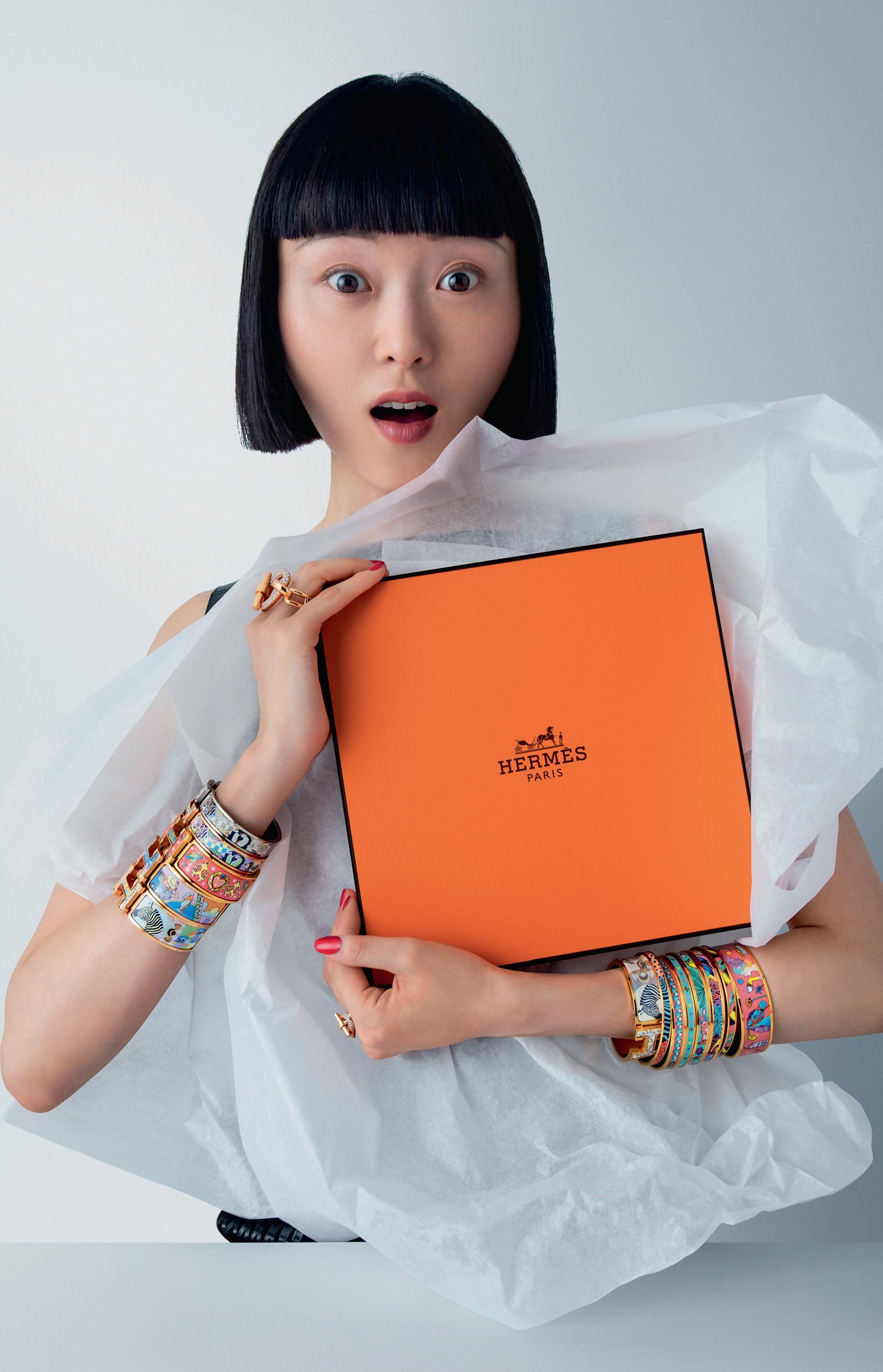
Herbert Blomstedt
SWEDISH-AMERICAN CONDUCTOR
Herbert Blomstedt has been leading orchestras for nearly 70 years. His leadership and artistry are especially associated with the San Francisco Symphony, Leipzig Gewandhaus Orchestra, and Dresden Staatskapelle. Mr. Blomstedt first conducted The Cleveland Orchestra in April 2006, and most recently led the Orchestra in February 2022 at Severance Music Center.
Born in Springfield, Massachusetts, in 1927 to Swedish parents, Mr. Blomstedt began his musical education at the Royal Academy of Music in Stockholm and at the University of Uppsala. He later studied conducting at The Juilliard School, contemporary music in Darmstadt, and Renaissance and Baroque music at the Schola Cantorum Basiliensis. He also worked with Igor Markevitch in Salzburg and Leonard Bernstein at Tanglewood.
In 1954, Mr. Blomstedt made his conducting debut with the Stockholm Philharmonic Orchestra. He subsequently served as music director of the Danish Radio Symphony Orchestra, Oslo Philharmonic, Dresden Staatskapelle, and the Swedish Radio Symphony Orchestra. He is conductor laureate of the San Francisco Symphony, which he served as music director from 1985–95. He was subsequently music director of Hamburg’s NDR Symphony Orchestra and of Leipzig’s Gewandhaus.
In recent years, Herbert Blomstedt has been named honorary conductor

of the Bamberg Symphony Orchestra, Leipzig Gewandhaus Orchestra, Tokyo’s NHK Symphony Orchestra, and the Danish and Swedish radio symphony orchestras. In addition to these, he regularly guest conducts with many of the world’s greatest orchestras.
Mr. Blomstedt’s extensive discography includes more than 130 works with the Dresden Staatskapelle and the complete works of Carl Nielsen with the Danish Radio Symphony. His award-winning recordings with the San Francisco Symphony are on Decca/London. His collaborations with other ensembles, including the Leipzig Gewandhaus Orchestra, can be heard on Decca, Deutsche Grammophon, and RCA Red Seal. He has recorded the complete Bruckner symphonies for the German label Querstand.
Among Mr. Blomstedt’s honors are several doctoral degrees and membership in the Royal Swedish Music Academy. In 2003, he received the German Federal Cross of Merit.
THE CLEVELAND ORCHESTRA | 15 clevelandorchestra.com THE CONDUCTOR
PHOTO BY ROGER MASTROIANNI
Emanuel Ax, piano
PIANIST EMANUEL AX was born in Lviv, Ukraine, and moved to Winnipeg, Canada, with his family as a young boy. He was a student of Mieczyslaw Munz at The Juilliard School and completed his graduate work at Columbia University. Mr. Ax captured public attention in 1974 when he won the first Arthur Rubinstein International Piano Competition in Tel Aviv, followed by the coveted Avery Fisher Prize in 1979.

Mr. Ax performs in recital and with major symphony orchestras around the world. He has appeared regularly at the
BBC Proms, Blossom Music Festival, Edinburgh Festival, Hollywood Bowl, Mostly Mozart Festival, Ravinia Festival, and Tanglewood, among others.
As a frequent and committed partner for chamber music, he has worked regularly with artists such as Young-Uck Kim, Jaime Laredo, Cho-Liang Lin, Yo-Yo Ma, Edgar Meyer, Peter Serkin, and Isaac Stern. He is a proponent of contemporary composers and has had works written for him by John Adams, Samuel Adams, HK Gruber, Krzysztof Penderecki, Christopher Rouse, and Melinda Wagner, among others.
He recorded more than 20 albums for RCA Records and has been an exclusive Sony Classical recording artist since 1987. Mr. Ax has won seven Grammys, including awards for his second and third volumes of Haydn piano sonatas, as well as a series of recordings of Beethoven and Brahms cello sonatas with Yo-Yo Ma. Other recordings include an album of tangos by Astor Piazzolla, Liszt and Schoenberg concertos, solo works by Brahms, and the world premiere of John Adams’s Century Rolls with The Cleveland Orchestra.
Mr. Ax resides in New York City with his wife, pianist Yoko Nozaki. They have two children together, Joseph and Sarah. He is a fellow of the American Academy of Arts and Sciences and holds honorary music doctorates from Columbia University, Skidmore College, and Yale University.
16 | 2022/2023 SEASON
THE ARTIST
PHOTO BY LISA MARIE MAZZUCCO
State and federal dollars through the Ohio Arts Council supported your arts experience today.



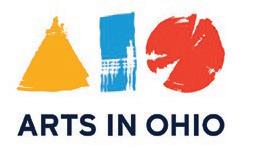

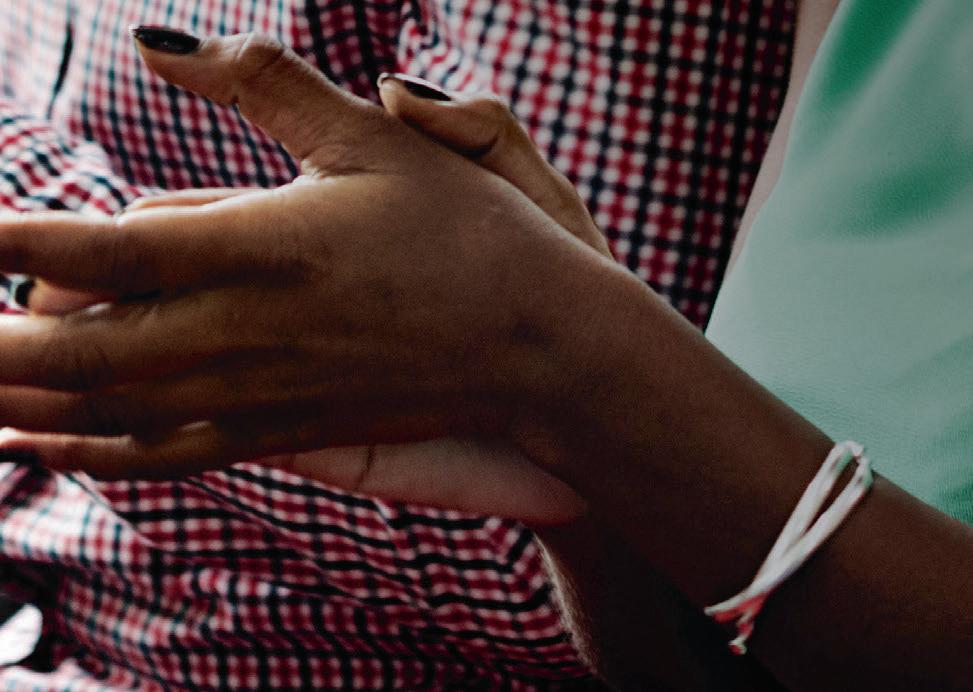

WHERE WILL THE ARTS TAKE YOU NEXT ? VISIT ARTSINOHIO.COM

@OHIOARTSCOUNCIL | #ARTSOHIO | OAC.OHIO.GOV
TWO
LJI builds confidence in every customer and ensures quality repairs and superior customer service. Our commitment is to achieve and retain customer loyalty for life!
Customer
NOW TWO LOCATIONS
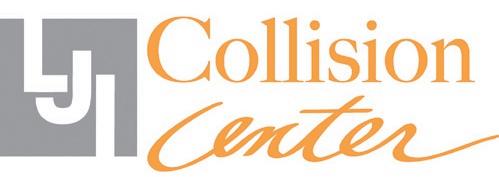

LJI builds confidence in every customer and ensures quality repairs and superior customer service. Our commitment is to achieve and retain customer loyalty for life!


27100 Chagrin Blvd. at I-271 Orange Village (216)364-7100 1640 Lee Rd. at Mayfield Cleveland Hts. (216) 932-7100
LOCATIONS Customer Confidence – Priority One™ ljicollisioncenter.com
Confidence –Lauren Angie Jill Strauss fourth generation in the industry
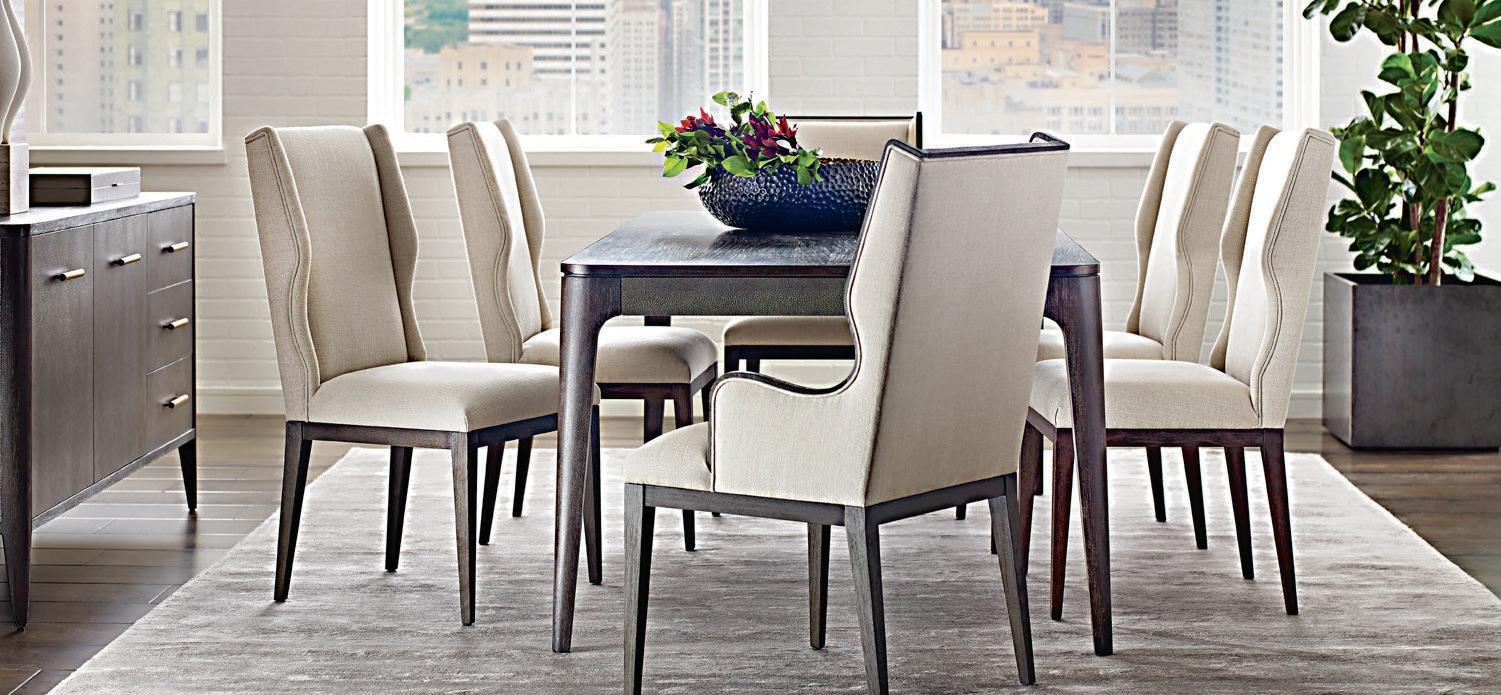

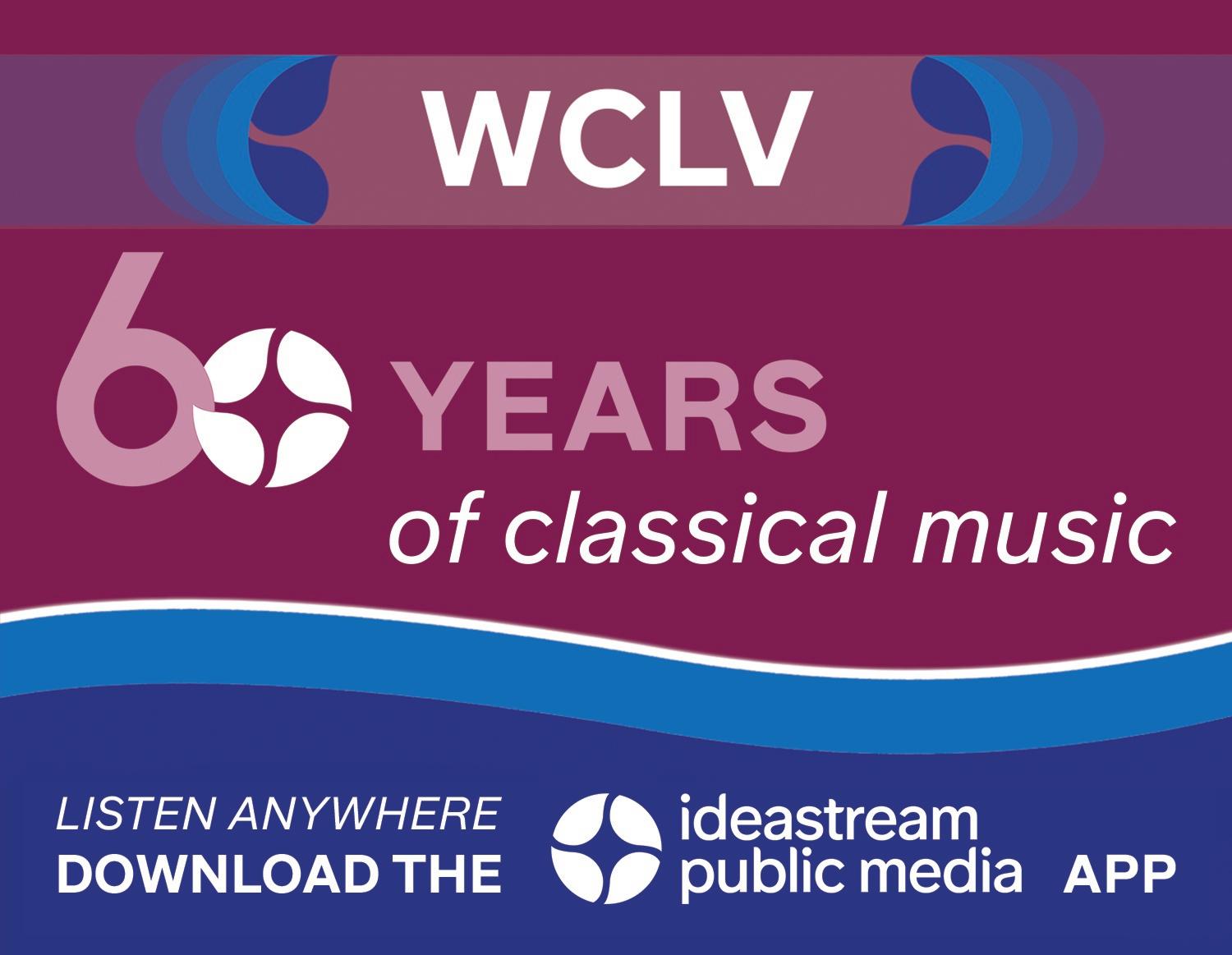
Let our cast of designers help you decide which style is right for your home. Undecided Where To Sit? 34300 Solon Road | Solon, OH | 440-248-2424 | 800-260-2949 One block south of Rt. 422 & SOM Center Road 9-9 M/Th | 9-5:30 Tu/W/F/Sa | www.sedlakinteriors.com Complimentary Delivery and Set-Up Within 60 Miles. CELEBRATING






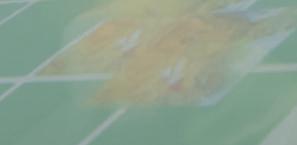




















IF YOU’RE LOOKING TO E P L O R E ON L I NE ClevelandArtsEvents .com connects you to the region’s vibrant arts and culture scene. With just a few clicks, discover hundreds of events made possible in part with public funding from Cuyahoga Arts & Culture. get in touch with art. ARTLENS Gallery | The Cleveland Museum of Art IMAGE COURTESY OF











Do YOU LOVE Horseshoe Lake? Do YOU want to HELP SAVE Horseshoe Lake? Check Out the Horseshoe Lake Restoration Plan www.SaveHorseshoeLake.com/FOHSL-Plan TCO REWARDS It’s easy to get TCO Rewards points and earn your way toward great perks like seat upgrades, merchandise, exclusive content, and more! IT’S FREE TCO Rewards are a FREE feature of your Cleveland Orchestra account. Simply login, or create an account and click Rewards. IT’S EASY Earn points for all the things you already do with The Cleveland Orchestra, such as attend concerts, watch videos, and read articles. GREAT PERKS Use your points to get great perks like tickets, merchandise, VIP experiences, and exclusive content. SPECIAL OFFER Enter 2223PROGRAM and earn 10 bonus points clevelandorchestra.com/rewards The place for fans of The Cleveland Orchestra!
NOW IN ITS SECOND CENTURY , The Cleveland Orchestra, under the leadership of music director Franz WelserMöst since 2002, is one of the most sought-after performing ensembles in the world. Year after year, the ensemble exemplifies extraordinary artistic excellence, creative programming, and community engagement. The New York Times has called Cleveland “the best in America” for its virtuosity, elegance of sound, variety of color, and chamberlike musical cohesion.
Founded by Adella Prentiss Hughes, the Orchestra performed its inaugural concert in December 1918. By the middle of the century, decades of growth and sustained support had turned it into one of the most admired globally.
The past decade has seen an increasing number of young people attending concerts, bringing fresh attention to The Cleveland Orchestra’s legendary sound and committed programming. More recently, the Orchestra launched several bold digital projects, including the streaming broadcast series In Focus, the podcast On a Personal Note, and its own recording label, a new chapter in the Orchestra’s long and distinguished recording and broadcast history. Together, they have captured the Orchestra’s unique artistry and the musical achievements of the Welser-Möst and Cleveland Orchestra partnership.

The 2022/23 season marks Franz Welser-Möst’s 21st year as music director, a period in which The Cleveland Orchestra earned unprecedented acclaim around the world, including a series of residencies at the Musikverein in Vienna, the first of its kind by an American orchestra, and a number of acclaimed opera presentations.
Since 1918, seven music directors — Nikolai Sokoloff, Artur Rodziński, Erich Leinsdorf, George Szell, Lorin Maazel, Christoph von Dohnányi, and Franz Welser-Möst — have guided and shaped the ensemble’s growth and sound. Through concerts at home and on tour, broadcasts, and a catalog of acclaimed recordings, The Cleveland Orchestra is heard today by a growing group of fans around the world.

22 | 2022/2023 SEASON THE CLEVELAND ORCHESTRA
@clevelandorchestra @CleveOrchestra @Cleveorch
@ClevelandOrchestra
PHOTO BY ROGER MASTROIANNI
THE CLEVELAND ORCHESTRA DIGITAL CONCERTS STREAMING NOW!
Adella, our streaming service and app, features on-demand portraits, music showcases, behind-the-scenes footage and our flagship In Focus premium concert series, available anytime & anywhere
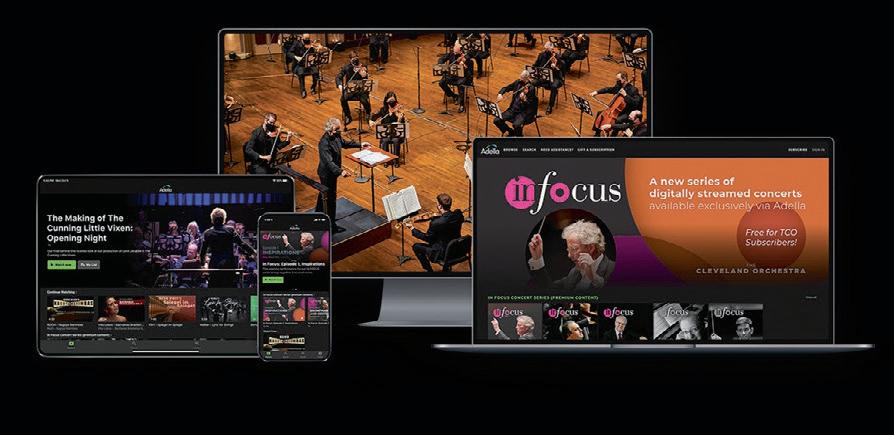
Now Available
The Seeker, Herbert Blomstedt
This weekend’s guest conductor leads The Cleveland Orchestra in Nielsen’s Fourth Symphony (“The Inextinguishable”), and offers a glimpse into his incredible career.
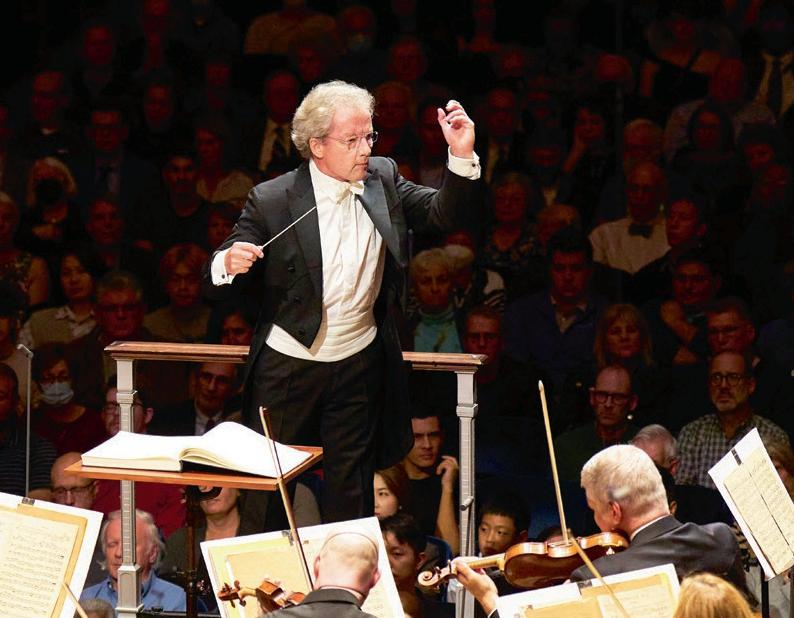

Mahler’s Resurrection
Pegged to the transformative gift of Mahler’s autograph score of the Second Symphony to The Cleveland Orchestra, Franz Welser-Möst leads a riveting performance of this powerful work.
Visit Adella.live to start your free trial.
THE CLEVELAND ORCHESTRA
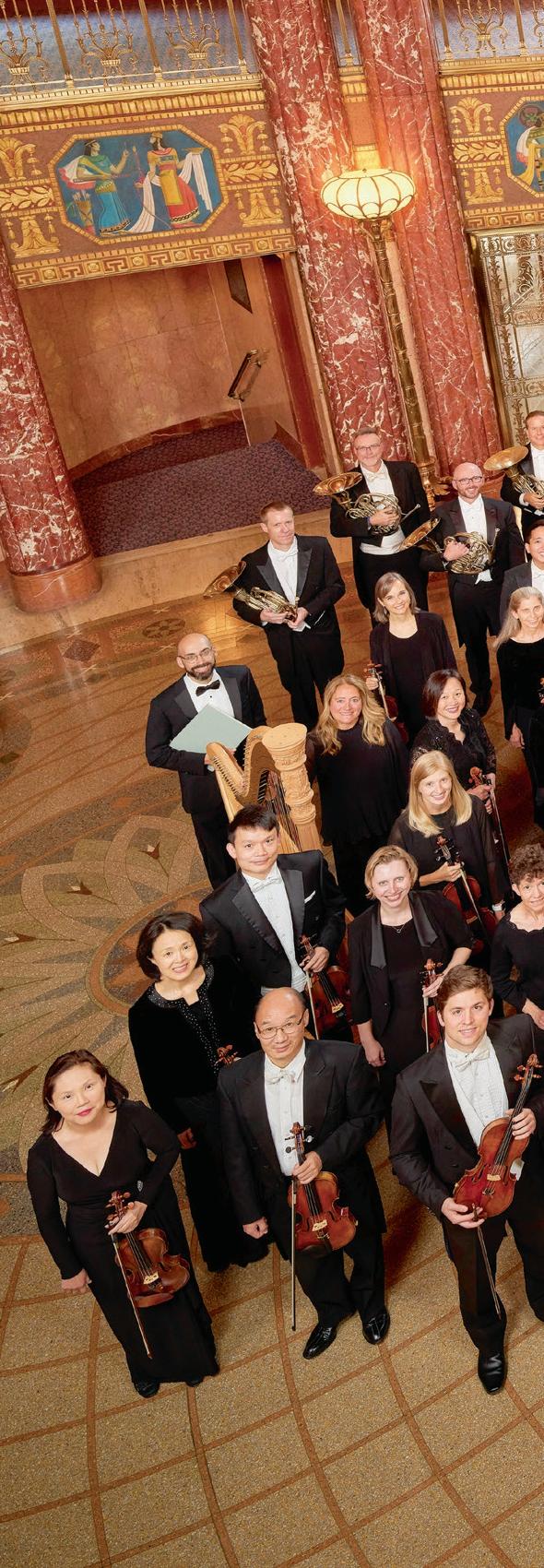
Franz Welser-Möst, MUSIC DIRECTOR
Kelvin Smith Family Chair
FIRST VIOLINS
David Radzynski
CONCERTMASTER
Blossom-Lee Chair
Peter Otto
FIRST ASSOCIATE CONCERTMASTER
Virginia M. Lindseth, PhD, Chair
Jung-Min Amy Lee
ASSOCIATE CONCERTMASTER
Gretchen D. and Ward Smith Chair
Jessica Lee
ASSISTANT CONCERTMASTER
Clara G. and George P.
Bickford Chair
Stephen Tavani
ASSISTANT CONCERTMASTER
Wei-Fang Gu
Drs. Paul M. and Renate H.
Duchesneau Chair
Kim Gomez
Elizabeth and Leslie
Kondorossy Chair
Chul-In Park
Harriet T. and David L.
Simon Chair
Miho Hashizume
Theodore Rautenberg
Chair
Jeanne Preucil Rose
Larry J.B. and Barbara S.
Robinson Chair
Alicia Koelz
Oswald and Phyllis Lerner
Gilroy Chair
Yu Yuan
Patty and John Collinson
Chair
Isabel Trautwein
Trevor and Jennie Jones
Chair
Katherine Bormann
Analisé Denise Kukelhan
Gladys B. Goetz Chair
Zhan Shu
SECOND VIOLINS
Stephen Rose*
Alfred M. and Clara T.
Rankin Chair
Eli Matthews1
Patricia M. Kozerefski and Richard J. Bogomolny
Chair
Sonja Braaten Molloy
Carolyn Gadiel Warner
Elayna Duitman
Ioana Missits
Jeffrey Zehngut
Sae Shiragami
Kathleen Collins
Beth Woodside
Emma Shook
Dr. Jeanette Grasselli
Brown and Dr. Glenn R. Brown Chair
Yun-Ting Lee
Jiah Chung Chapdelaine
VIOLAS
Wesley Collins*
Chaillé H. and Richard B.
Tullis Chair
Lynne Ramsey1
Charles M. and Janet G.
Kimball Chair
Stanley Konopka2
Mark Jackobs
Jean Wall Bennett Chair
Lisa Boyko
Richard and Nancy
Sneed Chair
Richard Waugh
Lembi Veskimets
The Morgan Sisters Chair
Eliesha Nelson
Joanna Patterson Zakany
William Bender
Gareth Zehngut
CELLOS
Mark Kosower*
Louis D. Beaumont Chair
Richard Weiss1
The GAR Foundation Chair
Charles Bernard2
Helen Weil Ross Chair
Bryan Dumm
Muriel and Noah Butkin
Chair
Tanya Ell
Thomas J. and Judith Fay
Gruber Chair
Ralph Curry
Brian Thornton
William P. Blair III Chair
David Alan Harrell
Martha Baldwin
Dane Johansen
Paul Kushious
BASSES
Maximilian Dimoff*
Clarence T. Reinberger Chair
Derek Zadinsky2
Mark Atherton
Thomas Sperl
Henry Peyrebrune
Charles Barr Memorial Chair
Charles Carleton
Scott Dixon
Charles Paul
HARP
Trina Struble*
Alice Chalifoux Chair
FLUTES
Joshua Smith*
Elizabeth M. and William C. Treuhaft Chair
Saeran St. Christopher
Jessica Sindell2
Austin B. and Ellen W.
Chinn Chair
Mary Kay Fink
PICCOLO
Mary Kay Fink
Anne M. and M. Roger Clapp Chair
OBOES
Frank Rosenwein*
Edith S. Taplin Chair
Corbin Stair
Sharon and Yoash Wiener Chair
Jeffrey Rathbun2
Everett D. and Eugenia S. McCurdy Chair
Robert Walters
ENGLISH HORN
Robert Walters
Samuel C. and Bernette K. Jaffe Chair
CLARINETS
Afendi Yusuf*
Robert Marcellus Chair
Robert Woolfrey
Victoire G. and Alfred M. Rankin, Jr. Chair
Daniel McKelway2
Robert R. and Vilma L. Kohn Chair
Amy Zoloto
E-FLAT CLARINET
Daniel McKelway
Stanley L. and Eloise M. Morgan Chair
BASS CLARINET
Amy Zoloto
Myrna and James Spira Chair
BASSOONS
John Clouser*
Louise Harkness Ingalls Chair
Gareth Thomas
Barrick Stees2
Sandra L. Haslinger Chair
Jonathan Sherwin
CONTRABASSOON
Jonathan Sherwin
HORNS
Nathaniel Silberschlag*
George Szell Memorial Chair
24 | 2022/2023 SEASON
Michael Mayhew§ Knight Foundation Chair
Jesse McCormick
Robert B. Benyo Chair
Hans Clebsch
Richard King
TRUMPETS
Michael Sachs* Robert and Eunice Podis
Weiskopf Chair
Jack Sutte
Lyle Steelman2
James P. and Dolores D. Storer Chair
Michael Miller
CORNETS
Michael Sachs*
Mary Elizabeth and G. Robert Klein Chair
Michael Miller
TROMBONES
Brian Wendel*
Gilbert W. and Louise I. Humphrey Chair
Richard Stout Alexander and Marianna C. McAfee Chair
Shachar Israel2
EUPHONIUM & BASS TRUMPET
Richard Stout
TUBA
Yasuhito Sugiyama*
Nathalie C. Spence and Nathalie S. Boswell Chair
TIMPANI
Paul Yancich*
Otto G. and Corinne T. Voss Chair
PERCUSSION
Marc Damoulakis*
Margaret Allen Ireland Chair
Donald Miller
Thomas Sherwood
KEYBOARD INSTRUMENTS
Carolyn Gadiel Warner
Marjory and Marc L. Swartzbaugh Chair
LIBRARIANS
Michael Ferraguto
Joe and Marlene Toot Chair
Donald Miller
ENDOWED CHAIRS CURRENTLY UNOCCUPIED
Elizabeth Ring and William
Gwinn Mather Chair
Paul and Lucille Jones Chair
James and Donna Reid
Chair
Mary E. and F. Joseph Callahan Chair
Sunshine Chair
Mr. and Mrs. Richard K. Smucker Chair
Rudolf Serkin Chair
CONDUCTORS
Christoph von Dohnányi MUSIC DIRECTOR
LAUREATE
Daniel Reith
ASSISTANT CONDUCTOR
Sidney and Doris Dworkin Chair
Lisa Wong
DIRECTOR OF CHORUSES
Frances P. and Chester C. Bolton Chair
* Principal
§ Associate Principal
1 First Assistant Principal
2 Assistant Principal
This roster lists full-time members of The Cleveland Orchestra. The number and seating of musicians onstage varies depending on the piece being performed. Seating within the string sections rotates on a periodic basis.
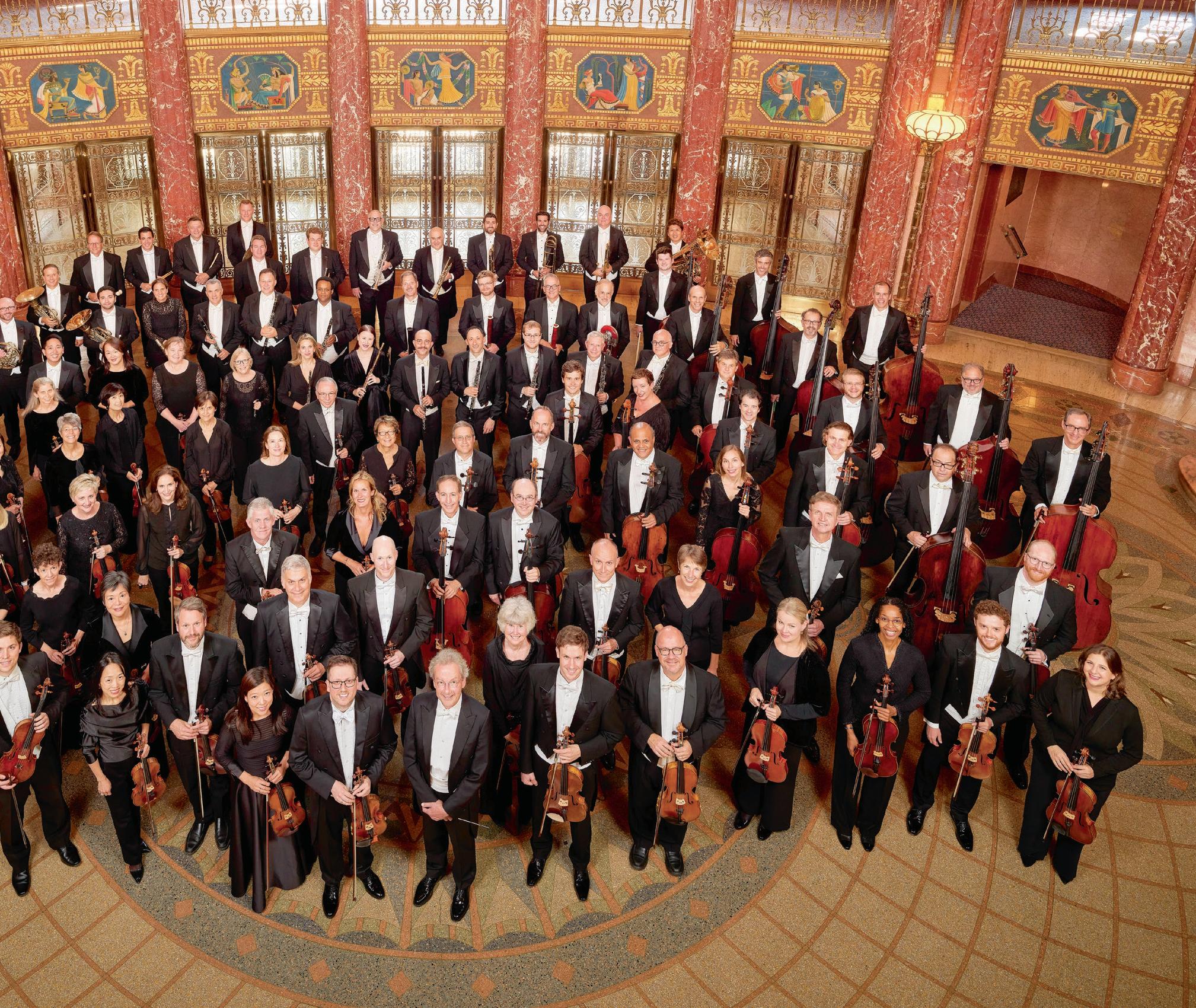
THE CLEVELAND ORCHESTRA | 25 clevelandorchestra.com
PHOTO BY ROGER MASTROIANNI
clevelandorchestra.com
WINTER SPRING
FEB 16, 17, 18
BEETHOVEN’S SEVENTH
Herbert Blomstedt, conductor
Emanuel Ax, piano
MOZART Piano Concerto No. 18 (“Paradis”)
BEETHOVEN Symphony No. 7
FEB 23, 24, 25
MOZART AND STRAUSS
Franz Welser-Möst, conductor
MOZART Divertimento No. 2*
SCHOENBERG Variations for Orchestra
STRAUSS Ein Heldenleben
* not part of Friday Matinee concert
MAR 2, 3, 4, 5
PICTURES AT AN EXHIBITION
Franz Welser-Möst, conductor
Víkingur Ólafsson, piano
FARRENC Symphony No. 3
RAVEL Piano Concerto in G major MUSSORGSKY/RAVEL Pictures at an Exhibition
MAR 9, 10, 11, 12
MOZART’S REQUIEM
Franz Welser-Möst, conductor
Christoph Sietzen, percussion
Siobhan Stagg, soprano
Avery Amereau, alto
Ben Bliss, tenor
Anthony Schneider, bass
Cleveland Orchestra Chorus
STAUD Concerto for Percussion
MOZART Requiem
MAR 30, 31, & APR 1
INSPIRATION: THE TEMPEST
Thomas Adès, conductor
Pekka Kuusisto, violin
ADÈS The Tempest Symphony
ADÈS Märchentänze
SIBELIUS Six Humoresques*
SIBELIUS Prelude and Suite No. 1 from The Tempest*
* Certain selections will not be part of the Friday Matinee concert
APR 6, 7, 8
SHOSTAKOVICH’S FIFTH SYMPHONY
Rafael Payare, conductor
Jean-Yves Thibaudet, piano
BERNSTEIN Symphony No. 2 (“The Age of Anxiety”)
SHOSTAKOVICH Symphony No. 5
APR 13, 15, 16
MAHLER’S TITAN
Michael Tilson Thomas, conductor
Leif Ove Andsnes, piano
DEBUSSY Jeux, poème dansé
DEBUSSY Fantaisie for Piano and Orchestra
MAHLER Symphony No. 1 (“Titan”)
APR 20, 21, 22, 23
ALL MOZART
Bernard Labadie, conductor
Lucy Crowe, soprano
MOZART Overture to La clemenza di Tito
MOZART “Giunse al fin il momento... Al desio di chi t’adora”
MOZART Ruhe Zanft from Zaide
MOZART Masonic Funeral Music
MOZART “Venga la morte... Non temer, amato bene”
MOZART Symphony No. 41 (“Jupiter”)
APR 27, 28, 29
MARSALIS AND NEW WORLD
Franz Welser-Möst, conductor
Michael Sachs, trumpet
MARTINŮ Symphony No. 2
MARSALIS Trumpet Concerto DVOŘÁK Symphony No. 9 (“From the New World”)
MAY 4, 6
WEILERSTEIN PLAYS BARBER
Franz Welser-Möst, conductor
Alisa Weilerstein, cello
LOGGINS-HULL Can You See?
BARBER Cello Concerto
PROKOFIEV Symphony No. 4
MAY 14, 17, 20
THE GIRL OF THE GOLDEN WEST
Franz Welser-Möst, conductor
Tamara Wilson, soprano (Minnie)
Eric Owens, bass (Jack Rance)
Limmie Pulliam, tenor (Dick Johnson)
Cleveland Orchestra Chorus
PUCCINI La Fanciulla del West (The Girl of the Golden West)
* Opera presentation, sung in Italian with projected supertitles
CALENDAR
MAR 9 | THU 7:30 PM
MAR 10 | FRI 7:30 PM
MAR 11 | SAT 8:00 PM












MAR 12 | SUN 3:00 PM



Franz Welser-Möst, conductor
Siobhan Stagg, soprano
Avery Amereau, alto

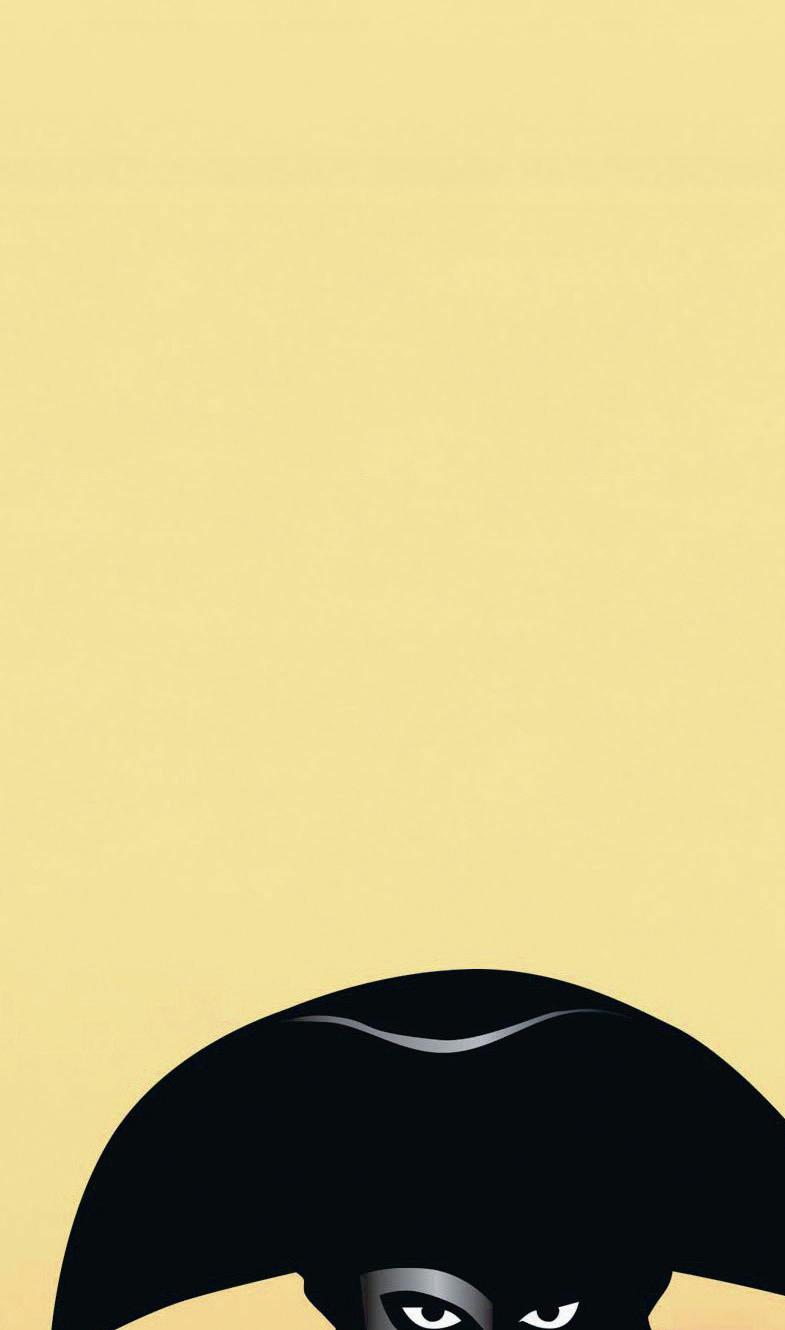
Ben Bliss, tenor
Anthony Schneider, Cleveland Orchestra Chorus
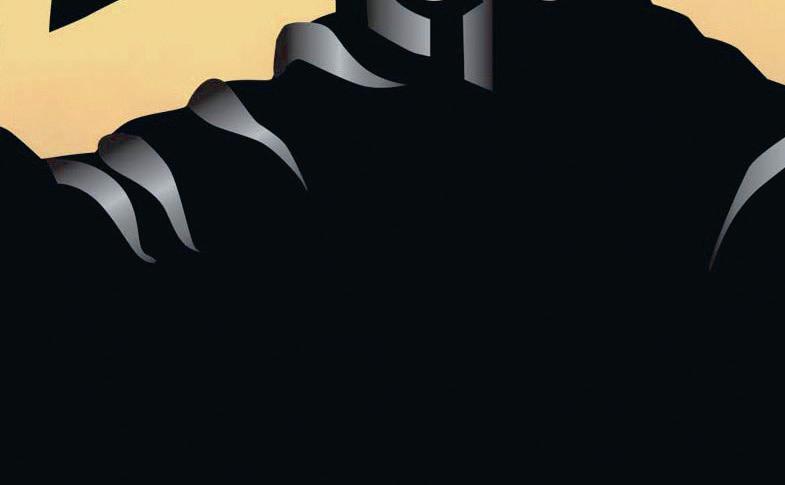
MOZART’S REQUIEM
TICKETS 216-231-1111
clevelandorchestra.com
|
YOUR VISIT
HEALTH & SAFETY
The Cleveland Orchestra is committed to creating a comfortable, enjoyable, and safe environment for all guests at Severance Music Center. While mask and COVID-19 vaccination are recommended they are not required. Protocols are reviewed regularly with the assistance of our Cleveland Clinic partners; for up-to-date information, visit: clevelandorchestra. com/attend/health-safety
LATE SEATING
As a courtesy to the audience members and musicians in the hall, late-arriving patrons are asked to wait quietly until the first convenient break in the program. These seating breaks are at the discretion of the House Manager in consultation with the performing artists.
PAGERS, CELL PHONES & WRISTWATCH ALARMS
As a courtesy to others, please silence all devices prior to the start of the concert.
PHOTOGRAPHY, VIDEOGRAPHY & RECORDING
Audio recording, photography, and videography are prohibited during performances at Severance. Photographs can only be taken when the performance is not in progress.
HEARING AIDS & OTHER HEALTH-ASSISTIVE DEVICES
For the comfort of those around you, please reduce the volume on hearing aids and other devices that may produce a noise that would detract from the program. For Infrared Assistive-Listening Devices, please see the House Manager or Head Usher for more details.
FREE MOBILE APP TICKET WALLET
IN THE EVENT OF AN EMERGENCY
Contact an usher or a member of house staff if you require medical assistance. Emergency exits are clearly marked throughout the building. Ushers and house staff will provide instructions in the event of an emergency.
AGE RESTRICTIONS
Regardless of age, each person must have a ticket and be able to sit quietly in a seat throughout the performance. Classical season subscription concerts are not recommended for children under the age of 8. However, there are several age-appropriate series designed specifically for children and youth, including Music Explorers (for 3 to 6 years old) and Family Concerts (for ages 7 and older).
The Cleveland Orchestra is grateful to the following organizations for their ongoing generous support of The Cleveland Orchestra: the State of Ohio and Ohio Arts Council and to the residents of Cuyahoga County through Cuyahoga Arts and Culture.
For more information and direct links to download, visit clevelandorchestra.com/ticketwallet or scan the code with your smartphone camera to download the app for iPhone or Android.
Available for iOS and Android on Google Play and at the Apple App Store.
The Cleveland Orchestra is proud of its long-term partnership with Kent State University, made possible in part through generous funding from the State of Ohio. The Cleveland Orchestra is proud to have its home, Severance Music Center, located on the campus of Case Western Reserve University, with whom it has a long history of collaboration and partnership.
© 2023 The Cleveland Orchestra and the Musical Arts Association
Program books for Cleveland Orchestra concerts are produced by The Cleveland Orchestra and are distributed free to attending audience members.
EDITOR
Amanda Angel
Managing Editor of Content
aangel@clevelandorchestra.com
DESIGN Elizabeth Eddins, eddinsdesign.com
ADVERTISING Live Publishing Company, 216-721-1800
28 | 2022/2023 SEASON
today for instant,
and
Download
secure
paperless access to your concert tickets.
clevelandorchestra.com Cleveland Orchestra performances are broadcast as part of regular programming on ideastream/WCLV Classical 90.3 FM, Saturdays at 8 p.m. and Sundays at 4 p.m.
is everything.
Photographs in Ink
Featuring works made in printer’s ink rather than produced in the darkroom or digitally, this exhibition explores how artists including Alfred Stieglitz, Andy Warhol, Lorna Simpson and more, have influenced photographic images since the 1850s.
Through April 2 | Tickets at cma.org | CMA Members FREE
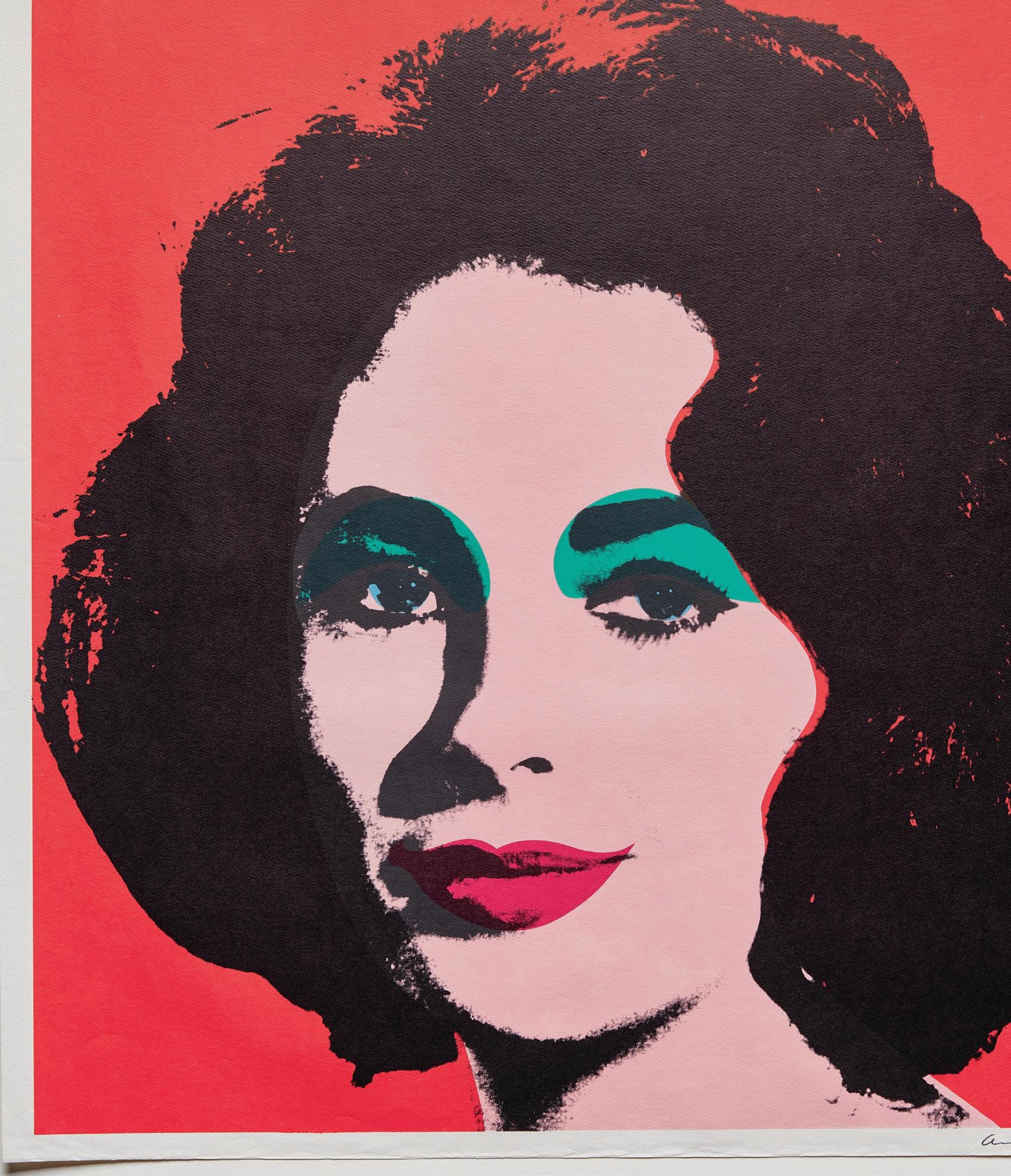
in part
the Ohio Arts
Ohio and the National
The Cleveland Museum of Art is funded in part by residents of Cuyahoga County through a public grant from Cuyahoga Arts & Culture. This exhibition was supported
by
Council, which receives support from the State of
Endowment for the Arts.
Liz, 1964. Andy Warhol (American, 1928–1987), Leo Castelli Gallery, New York. Color offset lithograph; sheet: 58.7 x 58.7 cm (23 1/8 x 23 1/8 in.); image: 55.8 x 55.8 cm (21 15/16 x 21 15/16 in.). The Cleveland Museum of Art, Gift of Harvey and Penelope D. Buchanan 1998.409 © 2023 The Andy Warhol Foundation for the Visual Arts, Inc. / Artists Rights Society (ARS), New York cma.org Image
A SYMPHONY OFSuccess

We believe that all Cleveland youth should have access to high-quality arts education. Through the generosity of our donors, we are investing to scale up neighborhoodbased programs that now serve 3,000 youth year-round in music, dance, theater, photography, literary arts and curatorial mastery. That’s a symphony of success. Find your passion, and partner with the Cleveland Foundation to make your greatest charitable impact.
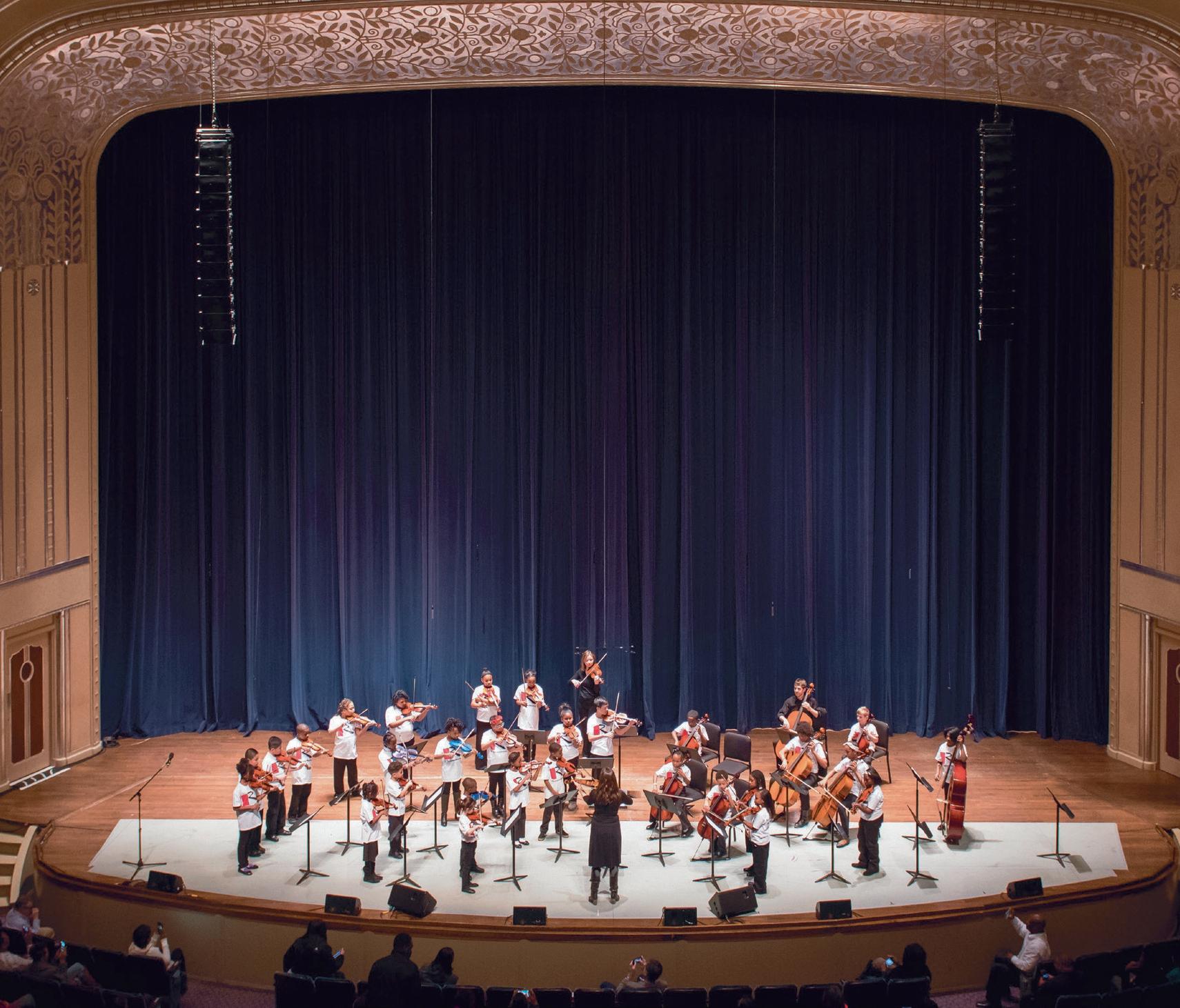
(877)554-5054
www.ClevelandFoundation.org
Institute
Rainey
El Sistema Orchestra











































































